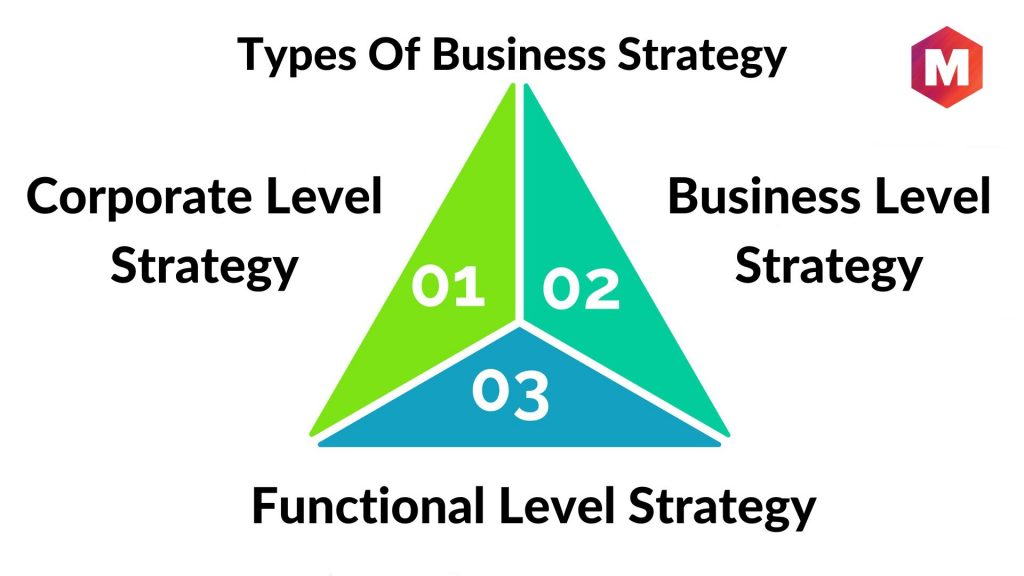Table of Contents
What is Corporate-Level Strategy?
Corporate-level strategy creates shareholder value through growth and profitability and gives overall direction to the business. Corporate-level strategy is the highest level of strategic decision-making within an organization.
The highest and most important strategy level within an organizational strategy is called corporate strategy. It’s responsible for decisions made about a company’s overall growth and direction. The corporate strategy also defines the specific goals and objectives that all other business units must work together to achieve.
Corporate-level strategies are usually set by a company’s top executives. Corporate-level strategy is important because it sets the tone for an entire organization.
The corporate-level strategy also encompasses the major decisions made about product offerings, geographic markets, and the nature of the company’s competitive advantages.
A dynamic corporate-level strategy evolves and adapts as the business grows and changes. It takes into account the company’s strengths and weaknesses, as well as opportunities and threats in the marketplace.
Meaning
Corporate-level strategy formulation is a process that begins with an evaluation of the internal and external environment. The external environment includes factors such as the economic climate, political landscape, technology, and social trends. The internal environment includes factors such as the company’s resources, capabilities, and culture.
Corporate-level strategies can be growth-oriented or defensive. Growth strategies seek to increase the size or scope of the business, while defensive strategies aim to protect the company’s existing market share or profits. There are three main types of growth strategies: horizontal growth, vertical growth, and concentric growth.
Horizontal growth strategy refers to expanding the company’s product offerings or geographic reach. It can also involve increasing the company’s market share through aggressive marketing or pricing initiatives. A vertical strategy seeks growth to increase the company’s sales or market share by moving up or down the value chain. For example, a company might vertically integrate by acquiring its suppliers or distributors.
A concentric growth strategy involves expanding into new markets that are similar to the company’s existing markets. For example, a company that sells computers might expand into selling computer accessories. The corporate-level strategy also encompasses the decision of whether to pursue a single business or multiple businesses (also known as diversification).
Corporate-level strategy implementing a vertical or horizontal growth strategy seeks growth by expanding the company’s operations into new markets or new product lines. The corporate-level strategy may also focus on ways to improve the efficiency and effectiveness of the company’s overall op marketplace.
Purpose of a Focused Corporate-Level Strategy
Some of the purposes behind formulating and implementing a Corporate-Level Strategy are as follows
- Corporate-level strategies help an organization to focus on its overall direction and long-term goal.
- It guides business units regarding what kind of products or services to offer, in which markets to operate, and how to create value for shareholders.
- It can also help an organization to allocate its resources efficiently.
- Corporate strategies provide a framework within which business units can operate independently and still be aligned with the organization’s overall goals.
- Corporate-level strategies can also help an organization respond quickly to changes in the external environment.
As the corporate-level strategy is one of the three types of business strategies, let’s take a look at all three business strategies-
3 Types Of Business Strategy
1. Corporate Level Strategy
Corporate-level strategy is the most important part of your business planning. It determines the main purpose of your business and drives all other strategies and decisions. Think of corporate-level strategy as the destination toward which your business is moving. That destination will affect everything else in your business, so it’s important to choose wisely.
2. Business Level Strategy
Once you’ve determined your corporate-level strategy, you can start making decisions about your business-level strategy. This type of strategy is all about how you’re going to compete in your chosen markets. Are you going to be a low-cost leader or differentiate your products and services? What kind of positioning will you use?
3. Functional Level Strategy
Functional-level strategies are all about how each department and individual functions (marketing, finance, HR, etc.). How can each function be best organized to support the business-level strategy and achieve the corporate-level goals is analyzed, planned, and executed at this level.
Types of corporate-level strategy
1. Stability strategy
A stability strategy is when a company chooses to maintain its current products, markets, and business operations. This type of strategy is usually used during periods of slow economic growth or when a company is trying to recover from a recent setback. The main goal of a stability strategy is to maintain the status quo. This means that businesses using this type of strategy will not make any major changes to their products, markets, or operations.
2. Expansion strategy
An expansion strategy is when a company chooses to grow its business by entering new markets or launching new products. This type of strategy is usually used during periods of economic growth. The main goal of an expansion strategy is to increase revenues and profits. This means that businesses using this type of strategy will be looking for ways to increase their sales and market share.
3. Retrenchment strategy
Retrenchment strategies are when a company chooses to reduce its costs by cutting back on its operations or withdrawing from certain markets. This type of strategy is usually used during periods of economic recession or when a company is facing financial difficulties. A retrenchment strategy’s primary objective is to bolster the company’s financial standing. Therefore, businesses that employed this tactic will be seeking ways to cut down on expenses.
4. Combination strategy
A combination strategy is when a company uses more than one of the above strategies at the same time. This type of strategy is usually used when a company is trying to recover from a recent setback or when the economy is in a state of flux. The key objective of a combination strategy is to sustain or enhance the organization’s financial performance while also making alterations to its merchandise, markets, or operations.
Characteristics of a Corporate-Level Strategy
The characteristics of a corporate-level strategy are
1. Diversification
Diversification is when a company enters into a new market or launches a new product. This can be done by either acquiring another company or starting from scratch. The key objective of a dominant business diversification strategy is to reduce the company’s reliance on its core business and to increase its growth potential.
2. Long Term
A corporate-level strategy is a long-term plan that is usually formulated with a time horizon of 3-5 years. This type of strategy is important because it allows companies to map out their future and make decisions accordingly.
3. Forward or backward integration
Integration is when a company either expands its operations into new areas or vertically backward into its supply chain. The key objective of integration is to increase the company’s efficiency and gain a competitive advantage.
4. Uncertain
A corporate-level strategy is often uncertain because it involves making decisions about the future direction of the company. This can be a difficult task, especially in times of economic uncertainty.
5. Horizontal integration
Horizontal integration is when a company expands its operations into new markets. The key objective of horizontal integration is to gain a larger market share.
6. Formulated From The Top Down
A corporate-level strategy is usually formulated by the top management of a company. This is because they have the best understanding of the company’s overall direction and objectives.
7. Profit
The main goal of a corporate-level strategy is to increase profits. This can be done by either increasing revenues or reducing costs.
8. Turnaround
A turnaround strategy is when a company decides to make changes to its operations in order to improve its financial performance. This type of strategy is usually used when a company is facing financial difficulties.
9. Divestment
Divestment is when a company sells off all or part of its operations. This can be done for a variety of reasons, such as reducing costs or exiting a market.
10. Market penetration
Market penetration is when a company expands its sales and marketing efforts in order to increase its market share. The key objective of market penetration is to gain a larger share of the existing market.
11. Liquidation
Liquidation is when a company sells off all of its assets and ceases operations. This is usually done when a company is facing bankruptcy.
12. Concentration
Concentration is when a company focuses its efforts on a particular product or market. The key objective of concentration is to gain a competitive advantage.
13. Investigation
An investigation is when a company looks into new markets or products. This can be done to find new growth opportunities.
14. No change
No change is when a company decides to maintain its current course of action. This can be done for a variety of reasons, such as stability or profitability.
15. Exit
An exit strategy is when a company decides to leave a particular market. This can be done for a variety of reasons, such as poor performance or changes in the market.
Here is a video by Marketing91 on Brand Name.
Benefits Of Corporate-Level Strategy
1. Enables a business to be proactive
A corporate-level strategy enables a business to be proactive rather than reactive. This means that you can make decisions in advance about the future direction of your company. This can help you to avoid financial difficulties and make the most of opportunities as they arise.
2. Offers strategic direction
A corporate-level strategy offers strategic direction for your business. This can help you to make decisions about where you want your company to go in the future. It can also help you to identify opportunities and threats that you may encounter along the way.
3. Increases efficiency
A corporate-level strategy can increase the efficiency of your business. This is because it can help you to make better use of your resources. It can also help you to reduce waste and duplication of effort.
4. Enables adaptation
A corporate-level strategy enables you to adapt to changes in the market. This means that you can respond quickly to new opportunities or threats. It will enable you to take advantage of changes in technology or the economy.
5. Increases profitability
A corporate-level strategy can increase the profitability of your business. It can help you to make better use of your resources. It can also let you find new markets and customers.
6. Increases market share
A corporate-level strategy can increase your market share. Identifying new markets and opportunities is essential for business growth. Keeping up with market changes can also help you to stay ahead of your competition.
7. Makes your business more durable
A corporate-level strategy can make your business more durable. This is because it can help you to adapt to changes in the market. It can also help you to find new markets and customers.
Conclusion!
Corporate-level strategy is the highest level of strategic planning in an organization. The corporate-level strategies define the stage for all business decisions made by identifying the overall direction the company is headed.
The targeted corporate-level strategies are influenced by the external business environment, including factors such as quality and supply needs. A company’s strategic planning process should take into account all of these factors to ensure that the company is making the best decisions possible. Corporate-level strategy is a critical part of any business and should not be taken lightly.
Thank you for reading! I hope this article was helpful in understanding corporate-level strategy. If you have any questions, please feel free to leave a comment below.
Liked this post? Check out the complete series on Strategy


